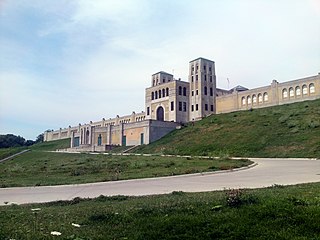The transport sector comprises the physical infrastructure, docks and vehicle, terminals, fleets, ancillary equipment and service delivery of all the various modes of transport operating in Guyana. The transport services, transport agencies providing these services, the organizations and people who plan, build, maintain, and operate the system, and the policies that mold its development.

Georgetown is the capital and largest city of Guyana. It is situated in Demerara-Mahaica, region 4, on the Atlantic Ocean coast, at the mouth of the Demerara River. It is nicknamed the "Garden City of the Caribbean." It is the retail, administrative, and financial services centre of the country, and the city accounts for a large portion of Guyana's GDP. The city recorded a population of 118,363 in the 2012 census.
Trans Guyana Airways Limited is a Guyanese airline which commenced operations in 1956 in Georgetown, Guyana, with a single float airplane. Since then, the company has expanded their fleet to provide domestic and regional transportation, and to Guyana's remote areas.

Toronto Water is the municipal division of the City of Toronto under Infrastructure and Development Services responsible for the water supply network, and stormwater and wastewater management in Toronto, Ontario, Canada, as well as parts of Peel and York Regions.
Ituni is a village in the interior of Guyana, at an altitude of 100 metres (331 feet). The area grew as a result of bauxite mining in the area.
The Railways of Guyana comprised two public railways, the Demerara-Berbice Railway and the Demerara-Essequibo Railway. There are also several industrial railways mainly for the bauxite industry. The Demerara-Berbice Railway is the oldest in South America. None of the railways are in operation in the 21st century.
Silver Hill is a very small settlement in the Demerara-Mahaica Region of Guyana, 48 km (30 mi) up the Soesdyke-Linden Highway, which runs along the east bank of the Demerara River.
Enmore is a village in the Demerara-Mahaica region along the coastal belt of Guyana. It is about two square miles (5.1 km2) in size and has a multi-ethnic population of 1,002 as of 2012,
Guyana, meaning "land of many waters", is rich in water resources. Most of the population is concentrated in the coastal plain, much of which is below sea level and is protected by a series of sea walls. A series of shallow reservoirs inland of the coastal plain, called "water conservancies", store surface water primarily for irrigation needs. Key issues in the water and sanitation sector in Guyana are poor service quality, a low level of cost recovery and low levels of access.
The Kashif & Shanghai Knockout Tournament was a knockout tournament of the Guyana football. It was created in 1990.
Guyana Power and Light (GPL) is a publicly owned utility company in Guyana, providing electric power in the country. Domestic voltage can be 110 or 220 depending on the area, both 50 and 60 cycle power. Services are provided from Charity to Moleson Creek, including the islands of Leguan and Wakenaam in the Essequibo River.

Mainstay Lake is a lake in the Pomeroon-Supenaam Region of Guyana, near the Atlantic coast, northwest of the mouth of the Essequibo River, 12 mi (19 km) north of Adventure. There is a 0.5 mi (0.80 km) stretch of white sand at the edge of the lake.
Sophia is a ward of Georgetown, the capital of Guyana. It's a predominantly Afro-Guyanese community, and one of Georgetown's poorest neighborhoods.
Marian Academy is a private Catholic nursery, primary and secondary school, located in Georgetown, Guyana. It is situated on Carifesta Avenue in central Georgetown.
Mining in Guyana is a significant contributor to the economy owing to sizable reserves of bauxite, gold, and diamonds. Much of these resources are found in Guyana's Hilly Sand and Clay belt, a region that makes up 20% of the country.
The COVID-19 pandemic in Guyana was a part of the worldwide pandemic of coronavirus disease 2019 caused by severe acute respiratory syndrome coronavirus 2. The virus was confirmed to have reached Guyana on 11 March 2020. The first case was a woman who travelled from New York, a 52-year-old woman with underlying health conditions, including diabetes and hypertension. The woman died at the Georgetown Public Hospital.
The 2005 Georgetown flood was a major flood in and around Georgetown, the capital of Guyana. It started during heavy rains in 2004, and came to a head in January, when sustained heavy rains and high tides over-topped the deteriorating water conservancy. Approximately 290,000 people were affected and the economic impact was estimated to be about US$465 million, or 59% of Guyana's GDP.



